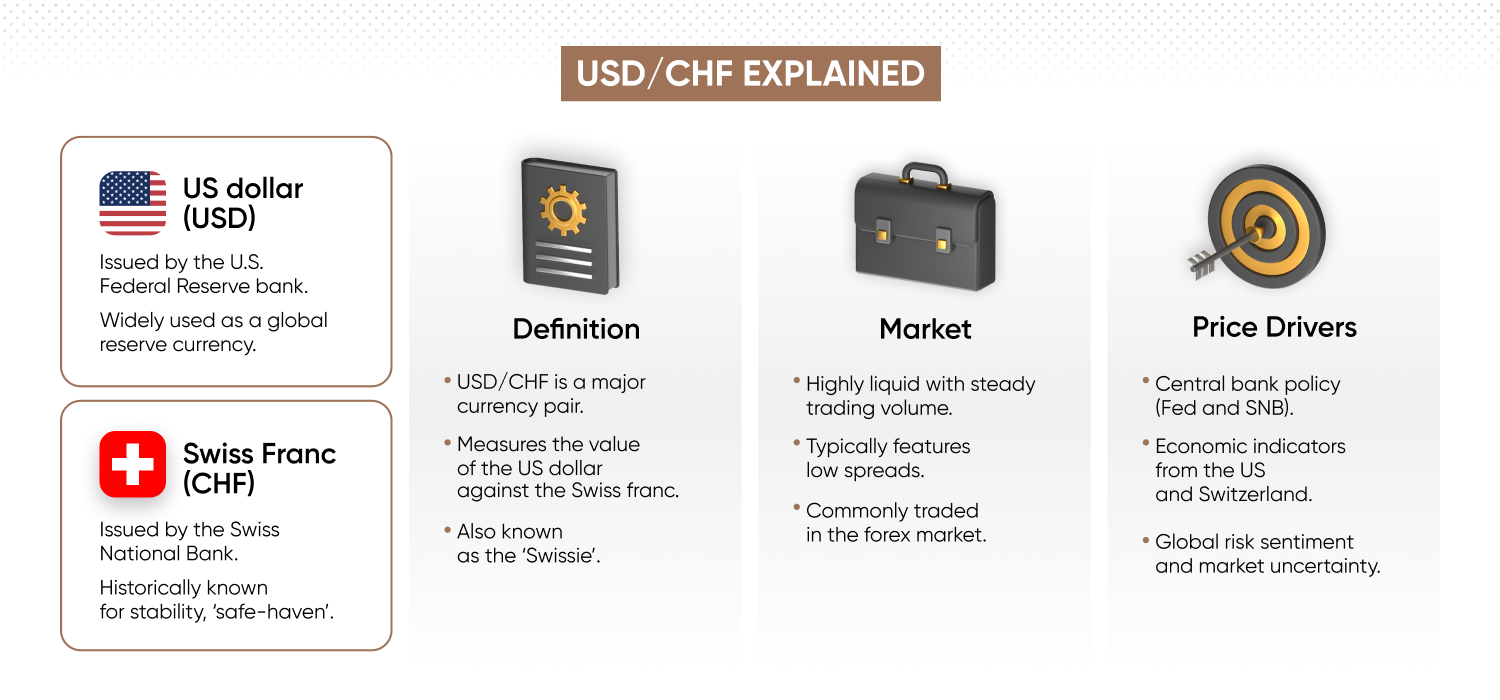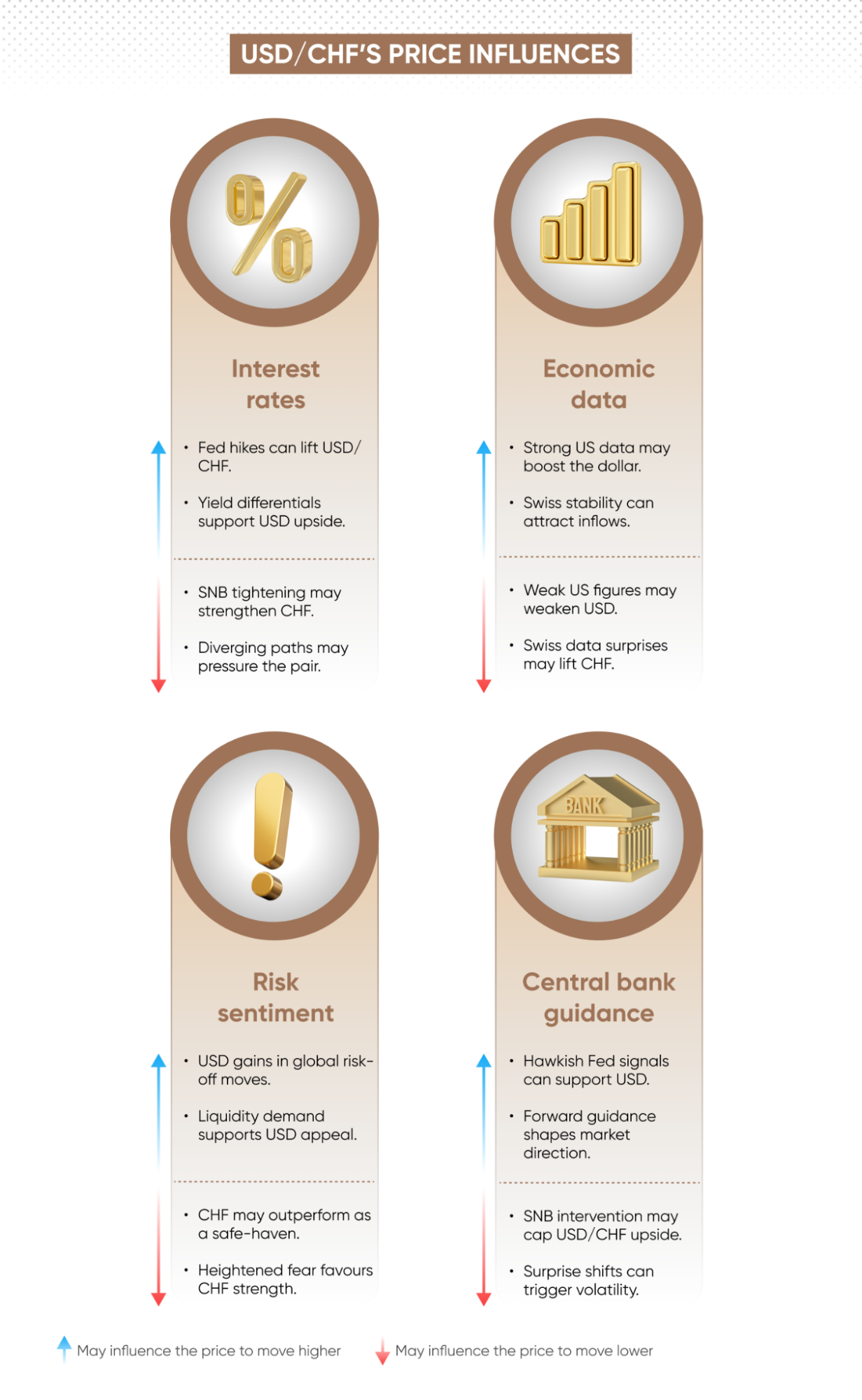What is USD/CHF (US dollar-Swiss franc pair), and how do you trade it?

Learn about EUR/USD, the world’s most traded forex pair. Explore its key price drivers, popular trading strategies, and how to trade EUR/USD via CFDs.
What is USD/CHF?
USD/CHF, commonly known as the ‘Swissie’, is a major currency pair measuring the value of the US dollar (USD) against the Swiss franc (CHF). It tells traders how many Swiss francs, the ‘quote’ currency, are needed to buy one US dollar, the ‘base’ currency’.
The US dollar is the world’s most widely held reserve currency, issued by the U.S. Federal Reserve bank. The Swiss franc, managed by the Swiss National Bank (SNB), is known for its long-standing stability, low inflation, and historical reputation as a safe-haven currency – particularly during periods of market uncertainty.
As a result, the US dollar to Swiss franc pair is liquid and widely traded in the forex market, with consistent trading volumes and relatively low spreads. The pair often reacts to central bank policy, economic data, and shifts in global risk sentiment.

Learn more in our comprehensive trader’s guides
Why trade USD/CHF?
Traders might consider potential USD/CHF trading opportunities, due to the pair’s distinct market characteristics.
-
Safe-haven dynamics: both the US dollar and Swiss franc are considered safe-haven currencies. The pair can highlight shifts in global risk sentiment, with CHF often strengthening in times of uncertainty.
-
Interest rate divergence: monetary policy from the Federal Reserve and Swiss National Bank can diverge significantly, potentially creating movement. The USD/CHF rate tends to react sharply to changes in rate expectations.
-
Liquidity and execution: as a major forex pair, USD/CHF can exhibit strong liquidity and tight spreads during key trading sessions, which can support efficient trade execution.
-
Technical reliability: the pair has historically formed clear technical setups and respects support/resistance levels, aiding short-term and swing trading strategies.
-
Economic data sensitivity: USD/CHF responds consistently to economic releases from the US and Switzerland, such as CPI, jobs data, and GDP figures.
Past performance doesn’t guarantee future results – USD/CHF’s rate can shift with changing macroeconomic and geopolitical conditions.
Potential risks of trading USD/CHF in forex
While USD/CHF presents unique potential, be aware of the following risks.
-
Central bank surprises: unexpected actions or commentary from the SNB or Fed can trigger sudden price movements, particularly due to Switzerland’s history of unconventional policy decisions.
-
Safe-haven reversals: during rapidly changing risk conditions, CHF may strengthen or weaken abruptly, especially when capital flows shift between global risk-on and risk-off sentiment.
-
Weekend gaps and news shocks: holding positions over weekends or during low-liquidity periods may expose traders to price gaps, leading to slippage or losses beyond initial targets.
Traders can use stop-loss and take-profit orders alongside trading strategies to manage risk when trading USD/CHF CFDs – learn more on our risk management page.
What influences the USD/CHF rate?
The USD/CHF rate is influenced by central bank policy, economic data, and shifts in global market sentiment. Each currency reacts to risk conditions in different ways.
Interest rate decisions (Fed and SNB)
The Fed often adjusts interest rates to manage inflation and employment, while the SNB has moved away from negative rates in recent years and, as of 2025, maintains a tightening bias aimed at containing inflation and managing franc strength. If the Fed raises rates while the SNB holds or cuts, USD/CHF may rise as investors seek higher USD yields. However, if the SNB signals tightening or intervenes to strengthen CHF, the pair may fall.
Economic indicators impacting USD/CHF
US data releases – such as CPI, non-farm payrolls, and GDP – tend to drive USD/CHF volatility more than Swiss figures. Strong US inflation or jobs data may lift the dollar on expectations of Fed hikes. Swiss indicators like CPI or the trade balance can influence the pair when they alter market expectations around SNB policy. CHF strength can also rise when Switzerland’s economic stability attracts capital inflows.
Risk sentiment and capital flows
USD and CHF both attract capital in times of uncertainty, but for different reasons. In forex, the Swiss franc is considered a traditional safe-haven, backed by Switzerland’s political neutrality and financial stability. The US dollar, also a major safe-haven, often gains during global risk-off moves thanks to its reserve currency role and deep liquidity. USD/CHF can fall when risk aversion favours the franc, or rise when broad-based dollar demand outweighs CHF strength.
Central bank guidance and FX intervention
Statements from Fed or SNB officials often influence USD/CHF by shaping rate expectations. The SNB also has a history of direct FX intervention to manage sharp or sustained franc strength, and unexpected guidance or policy moves can trigger sudden price movements in the pair.

Discover forex market price drivers and more on our market analysis page.
What are some top USD/CHF trading strategies?
US dollar to Swiss franc trading strategies can help align your positions with market dynamics. Historically, the pair has reacted to central bank policy shifts and changes in global risk sentiment, with scope for both technical and macro-based approaches.
-
Trend trading: uses technical indicators to identify sustained price direction. Trend traders might go long when USD/CHF forms higher highs and higher lows – sometimes coinciding with rising US interest rate expectations – or short when CHF strengthens on risk aversion.
-
Range trading: could be used during periods of low volatility, when USD/CHF moves within defined levels. Range traders typically buy near support and sell near resistance, using technical tools like RSI or Bollinger Bands to confirm entry points.
-
Position trading: takes a long-term view, holding trades over weeks or months. Position traders might follow broader themes such as inflation trends, interest rate cycles, or geopolitical shifts affecting capital flows.
-
Scalping trading: involves executing a high volume of quick trades to capture small price movements. Scalp traders might use shorter time frames – such as 1-minute or 5-minute charts.
Explore more about shares trading in our shares trading guide and on our trading strategies page.
What are USD/CHF’s forex trading hours & market overlaps?
USD/CHF trades 24 hours a day, five days a week, in line with global forex market hours.
The pair sees increased trading volume during the overlap of the London, Zurich, and New York sessions. Peak activity occurs between 1pm and 3pm UTC (summer), or 2pm and 4pm UTC (winter), when Zurich and New York are both open.*
Major trading sessions for USD/CHF forex pair:
|
Session |
Summer (UTC) |
Winter (UTC) |
|
Zurich |
6am to 3pm |
7am to 4pm |
|
New York |
12pm to 9pm |
1pm to 10pm |
|
London** |
7am to 4pm |
8am to 5pm |
Liquidity and volatility historically rise during these overlaps, especially when economic releases from the US or Switzerland coincide with broader market moves. These windows tend to offer the most consistent price action for USD/CHF strategies.
For detailed, up-to-date forex trading hours, visit our dedicated forex trading hours page.
*Session overlaps and volatility patterns are based on historical averages and may vary.
**While not directly tied to USD or CHF, London’s role as a global forex centre adds depth to USD/CHF liquidity, particularly during its overlap with Zurich.
How to trade USD/CHF CFDs with us
Trade USD/CHF with contracts for difference (CFDs) on our web platform or mobile apps – it only takes a few minutes to get started.
- 1. Create a trading account and complete the verification process.
- 2. Choose ‘USD/CHF’ from our CFD instrument list.
- 3. Set trade parameters, including position size, leverage, and stop-loss or take-profit levels.
- 4. Practise with a demo account to test your USD/CHF strategy with virtual funds.
- 5. Place your trade when ready, based on your strategy and market outlook.
- 6. Buy or sell? Select ‘buy’ if you expect USD/CHF to rise, or ‘sell’ if you think it will fall.
- 7. Monitor your position using our real-time charts, indicators, and risk management tools.
Our platform is designed for traders, with a user-friendly interface, integrated analysis tools, custom alerts, and dedicated support.
Ready to trade USD/CHF? Try our demo account and explore the pair in live market conditions.
FAQs
What currency is CHF?
CHF is the official currency code for the Swiss franc – the national currency of Switzerland (and Liechtenstein). It’s issued by the Swiss National Bank (SNB) and is widely regarded as a safe-haven currency due to Switzerland’s stable economy, low inflation, and strong fiscal framework. In forex trading, CHF is commonly paired with other major currencies such as the USD, EUR, and JPY.
When does the trading market open in CHF?
CHF can be traded 24 hours a day, five days a week, as part of the global forex market. Trading activity involving the Swiss franc typically begins during the Zurich session, which opens at 6am UTC in summer (7am UTC in winter). Liquidity increases further during the London and New York overlaps.
Is there an ETF for Swiss franc?
Yes, there are ETFs designed to provide exposure to the Swiss franc. These typically track the performance of CHF against other currencies or aim to replicate returns on CHF-denominated assets. However, ETFs are not direct forex instruments and do not offer the same real-time pricing, leverage, or flexibility as trading USD/CHF via CFDs.
Why is the Swiss franc so strong today?
The Swiss franc tends to strengthen in response to risk-off sentiment, geopolitical uncertainty, or expectations of reduced global growth. Recent gains may also reflect increased demand for the currency, lower inflation volatility, or market pricing of future SNB policy. As CHF is a defensive currency, strength is often linked to broader macroeconomic factors rather than domestic data alone.
Is USD/CHF a buy or sell?
USD/CHF’s outlook depends on prevailing market conditions, central bank policy, and broader risk sentiment. Traders may consider a ‘buy’ position if they anticipate dollar strength – for example, on rising US yields or strong data – or a ‘sell’ if the franc is expected to appreciate, often during periods of heightened market uncertainty. Any directional bias should be supported by technical analysis, strategy alignment, and sound risk management.